Читать книгу It All Adds Up: The Story of People and Mathematics - Stephen Wilson S., Mickael Launay - Страница 12
5 A LITTLE METHOD
ОглавлениеThe matter of the proof became one of the main fields of work for Greek mathematics. No theorem could be validated without being accompanied by a proof, meaning a piece of precise logical reasoning establishing its truth in a definitive manner. It has to be said that without the safeguard that proofs provide, mathematical results can sometimes hold some nasty surprises. Certain methods do not always work as well as they might, even though they may be recognized and widely used.
Do you recall the construction of the Rhind Papyrus for drawing a square and a circle of the same area? Well, it is incorrect. Only a little, certainly, but incorrect all the same. Measure the areas precisely, and they differ by about 0.5 per cent. While I agree that for surveyors and other geometers of land such accuracy may broadly suffice, it won’t do for theoretical mathematicians.
Pythagoras himself was caught out by false hypotheses. His most famous mistake concerned commensurable lengths. He believed that in geometry, two lengths are always commensurable – in other words, that it is possible to find a unit small enough that it will measure them both simultaneously. Imagine a line of length 9 centimetres and another of length 13.7 centimetres. The Greeks did not know about numbers with decimal points, they only measured lengths with whole numbers. Thus, for them, the second line was not measurable in centimetres. Never mind that, in this case, it is sufficient to take a unit ten times smaller to say that the two lines measure respectively 90 and 137 in millimetres. Pythagoras had convinced himself that regardless of their lengths, any two lines were always commensurable for some appropriate unit of measurement which remained to be determined.
However, his conviction was disproved by a Pythagorean called Hippasus of Metapontum. He discovered that in a square, the side and the diagonal are not commensurable. Whatever unit of measurement you may choose, it is not possible to measure both the side of the square and its diagonal simultaneously and arrive at a result in whole numbers. We call numbers like this ‘irrational’. Just as with the side of the square and its diagonal, it is equally impossible to measure the diameter and circumference of a circle in commensurable numbers. Hippasus provided a logical proof of this, which left no room for doubt about the question. Pythagoras and his disciples were so annoyed by this that Hippasus was excluded from the School. His discovery led to his being taken out to sea and thrown overboard by his fellow disciples – or so the story goes.
These anecdotes are terrifying for mathematicians. Can we never be sure about anything? Must we live in permanent fear that every mathematical discovery will eventually collapse? And what about the 3-4-5 triangle? Can we be absolutely certain that it is right-angled? Is there not a risk of one day discovering that the angle that, until then, seemed to be a perfect right angle is also only approximate?
It is still not uncommon for mathematicians to fall victim to deceptive intuition. That is why, following the search for rigour by their Greek counterparts, our mathematicians now take great care to differentiate between proven statements that they call ‘theorems’ and those known as ‘conjectures’, which they believe to be true, but for which they do not yet have a proof.
One of the most famous conjectures of our time is the so-called Riemann hypothesis. Numerous mathematicians are confident enough that this unproven hypothesis is true that they incorporate it as the basis for their research. The hope is that this conjecture will one day become a theorem, and all their work will then be validated. But if it were to be contradicted one day, all these bodies of work representing whole lifetimes of research would collapse with it. Scientists of the twenty-first century may be more reasonable than their Greek ancestors. However, we can understand that under these conditions, the mathematician announcing the invalidity of the Riemann hypothesis might make some of his colleagues want to throw him to the sharks.
It is in order to escape this permanent unease over refutation that mathematics needs proofs. No, we shall never discover that the 3-4-5 is not a right-angled triangle. It is one – that is for certain. And this certainty comes from the fact that Pythagoras’ theorem has a proof. Every triangle for which the sum of the squares of the two sides is equal to the square of the third side is a right-angled triangle. This statement was undoubtedly only a conjecture for the Mesopotamians. It became a theorem with the Greeks. Phew.
But then, what does a proof look like? Pythagoras’ theorem is not just the most famous of all theorems, it is also among those that have the greatest number of different proofs. There are at least a few dozen. Some of these were discovered independently by civilizations that had never heard of Euclid or of Pythagoras, as happens, for example, with the proofs that we find in the commentaries on the Chinese Nine Chapters
